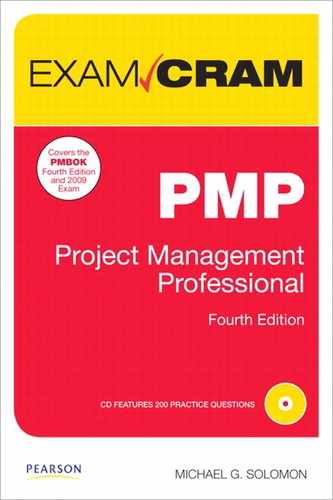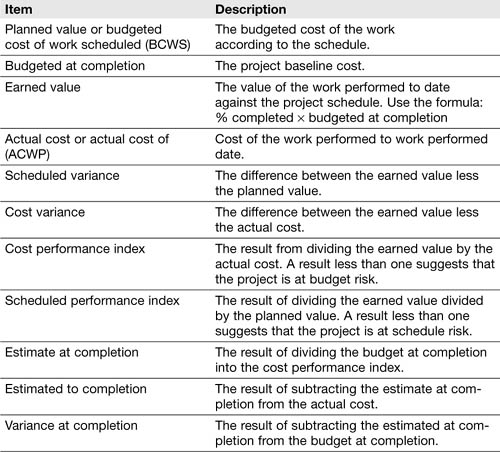Chapter 6
Investigate Project Monitoring and Controlling
Monitoring and controlling refers to all the activities and processes necessary to successfully manage a project and its associated risks. For the PMP exam, monitoring and controlling entails a total 10 out of the 42 project management processes defined in the PMBOK.
In essence, monitoring and controlling is all the effective activities that the project manager performs to keep project performance and resource utilization at optimal levels. The magnitude and frequency of these activities are dictated by the size and organizational impact of the project. No matter the size of the project, there are three core elements that support effective monitoring and controlling:
![]() Effective definition of project baseline and milestones
Effective definition of project baseline and milestones
![]() Effective tracking of project activities and resource utilization
Effective tracking of project activities and resource utilization
![]() Effective risk definition for proposed corrective or preventive actions
Effective risk definition for proposed corrective or preventive actions
The following sections address the various processes associated with monitoring and controlling and how these processes ensure the project stays on track.
Integration and Scope Management
![]() Monitor and Control Project Work—4.4
Monitor and Control Project Work—4.4
![]() Perform Integrated Change Control—4.5
Perform Integrated Change Control—4.5
![]() Verify Scope—5.4
Verify Scope—5.4
![]() Control Scope—5.5
Control Scope—5.5
The monitoring and controlling process group addresses eight of the nine PMI knowledge areas, permeating nearly all aspects of a project. The activities in this process group help to prescribe a measured and controlled project execution environment.
Figure 6.1 depicts how the process groups of the project management methodology are related, and that all of them must be monitored and controlled for effective project completion.
Factors That Cause Project Change
To effectively monitor and control a project, the project manager must prepare organizational processes that work like sentinels on the fence. These sentinels help the project manager identify events (people, cultural, or strategic) that might force a change to the project or the environment where the project is executing. In other words your project will be influenced by elements outside of its normal execution and identified risks. These processes can include elements, such as
![]() Execution trend analysis
Execution trend analysis
![]() Risk trigger management
Risk trigger management
![]() Forecast reports (just like the weather)
Forecast reports (just like the weather)
![]() Work package progress status and variances reports
Work package progress status and variances reports
![]() Lessons learned from similar projects
Lessons learned from similar projects
![]() Best practices
Best practices
![]() Corporate strategy committee resolutions
Corporate strategy committee resolutions
FIGURE 6.1 The project monitoring and controlling process group framework
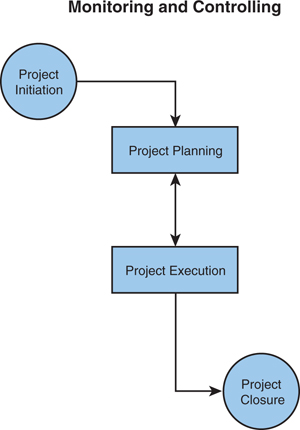
Some examples of project control processes and their elements are
![]() You could use earned value analysis to determine how your project is performing against the planned activities, schedule, and cost.
You could use earned value analysis to determine how your project is performing against the planned activities, schedule, and cost.
![]() You can prescribe corrective or preventive actions after performing trend analysis in work packages variances.
You can prescribe corrective or preventive actions after performing trend analysis in work packages variances.
![]() You can identify a potential project change request after evaluating defect and frequency control charts.
You can identify a potential project change request after evaluating defect and frequency control charts.
![]() When executing enterprise projects, you can arrange a monthly meeting with the company CEO to discuss progress and new corporate initiatives.
When executing enterprise projects, you can arrange a monthly meeting with the company CEO to discuss progress and new corporate initiatives.
Monitor and Control Project Work
The monitor and control project work process is the first process in the monitoring and controlling process group. This process formally specifies what the project manager requires as inputs to properly monitor and control the project execution activities. As with all other PMI processes, the monitor and control project work process also defines the tools and techniques that are used and the expected outputs of the process. Table 6.1 shows the inputs, tools and techniques, and outputs for the monitor and control project work process.
TABLE 6.1 Monitor and Control Project Work Inputs, Tools and Techniques, and Outputs

As you can see, this process is a high-level process that requires expert judgment on the part of the project manager to assess whether the project is within the constraints of the plan or not. Any deviations require intervention or requests for changes to the plan.
Perform Integrated Change Control
When an opportunity for change is identified, the project manager must make the time to acknowledge the request for change, evaluate its associated risks, and consider its potential not just to the timeline but also to scope, cost, staff, quality, make or buy, and communication. The perform integrated change control process helps you to identify if a requested change is gold plating or if it has direct effect to the project deliverables and its return on investment.
TABLE 6.2 shows the inputs, tools and techniques, and outputs for the perform integrated change control process.
TABLE 6.2 Perform Integrated Change Control Work Inputs, Tools and Techniques, and Outputs
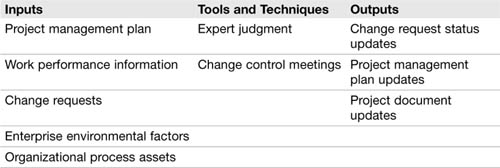
After you determine that a proposed change has merit and supports the project objectives, the change request is submitted to the project control team for final determinations. For the most part, the interaction with the control board is defined in the planning stage and can remain in place until the completion of the project. In the event that the organization has a project management office, the members of the change control board can change to accommodate strategic impact or affected areas in the project organization.
In addition, you should monitor any trends in requested changes that could indicate inadequate requirements definition in the planning stage of your project.
The Project Feedback Loop
Earlier chapters discussed the five distinct PMI process groups: initiating, planning, executing, monitoring and controlling, and closing. But what of the external changes that occur during the execution of your project? This is where iterative information gathering and dissemination processes serve as information feedback loops.
One of the challenges of the traditional linear methodology approaches is that they do not clearly provide methods to incorporate organizational changes midstream and do not verify their range to target impacts. In other words, a project without feedback loops makes the assumption that nothing outside the project will change throughout the life of project; the requirements will not change or are frozen.
Remember that enterprise changes can have a direct effect on the viability of the project. Some examples of events that you might want to be made aware of in advance are
![]() A hostile takeover
A hostile takeover
![]() A divestment of a business unit
A divestment of a business unit
![]() Personnel or resource availability reduction
Personnel or resource availability reduction
![]() A corporate relocation
A corporate relocation
Verifying and Controlling Project Scope
The scope management knowledge area defines two processes in the monitoring and controlling process group. The first process, verify scope, is the formal process of accepting project deliverables. It provides a mechanism to verify that deliverables meet or exceed project requirements. The second process, control scope, is the process of managing the project’s status and any changes to the scope baseline. Let’s look at each of the processes individually.
The verify scope process provides the project manager with the formal process to classify deliverables as acceptable or unacceptable. Table 6.3 shows the inputs, tools and techniques, and outputs for the verify scope process.
TABLE 6.3 Verify Scope Inputs, Tools and Techniques, and Outputs

One output of the verify scope process is the collection of change requests. These requests are individually addressed through the perform integrated change control process and might result in approved change requests.
The next process in the monitoring and controlling process group is the control scope process. This process monitors and controls all changes to the scope baseline to ensure the changes are being handled in a structured manner. Table 6.4 shows the inputs, tools and techniques, and outputs for the control scope process.
TABLE 6.4 Control Scope Inputs, Tools and Techniques, and Outputs
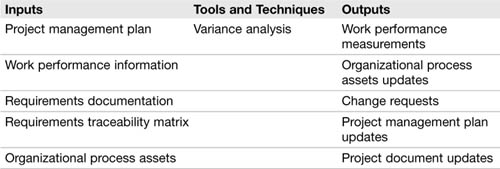
A primary component of the project management plan is the scope baseline. The scope baseline defines the project scope and its associated deliverables, and documents the acceptance parameters of the final product. This baseline helps in clarifying any details that might have been left in a to-be-determined (TBD) mode during the project initiation phase or items that require further clarification with the project sponsor or its stakeholders. The project process indicators in this process are
![]() The work breakdown structure (WBS)
The work breakdown structure (WBS)
![]() Work package progress reports
Work package progress reports
The idea behind effectively defining the WBS is to create the roadmap that defines all the activities that will be executed to accomplish the project goal.
The WBS is one of those elements that changes as time and resource utilization passes. Why? As you perform the tasks outlined in your baseline, the recorded changes accommodate any differences between the planned theory and the actual execution.
An effective WBS assists the stakeholders to understand the activities and events that help in delivering the project promise, as well as outlining internal and external resource use. The entire project execution team looks at the WBS to inquire about present, past, and future deliverables and their effectiveness.
Due to its nature and importance, the creation of the WBS should not be taken lightly. It must be considered as the one element that all project participants might want to be considered when formulating an opinion.
Cram Quiz
Answer these questions. The answers follow the last question. If you cannot answer these questions correctly, consider reading this section again until you can.
1. The change control system is a subsystem of what?
![]() A. Configuration management
A. Configuration management
![]() B. Project management
B. Project management
![]() C. Risk management
C. Risk management
![]() D. Scope management.
D. Scope management.
2. Approved change requests can cause a change to which of the following project elements?
![]() A. Scope
A. Scope
![]() B. Quality
B. Quality
![]() C. Schedule
C. Schedule
![]() D. All of the above
D. All of the above
3. Which of the following best describes the monitor and control project work process?
![]() A. Tracking, reviewing, and regulating the progress made toward fulfilling the project objectives
A. Tracking, reviewing, and regulating the progress made toward fulfilling the project objectives
![]() B. Performing the work defined in the project management plan
B. Performing the work defined in the project management plan
![]() C. Reviewing change requests, approving change requests, and managing changes to the project
C. Reviewing change requests, approving change requests, and managing changes to the project
![]() D. Monitor the status of the project and product scope, as well as changes to the scope baseline
D. Monitor the status of the project and product scope, as well as changes to the scope baseline
4. Which of the following is NOT a valid output of the verify scope process?
![]() A. Accepted deliverables
A. Accepted deliverables
![]() B. Work performance measurements
B. Work performance measurements
![]() C. Change requests
C. Change requests
![]() D. Project document updates
D. Project document updates
Cram Quiz Answers
1. Answer A is the correct response. The change control system is a subsystem of the configuration management system and, according to the PMBOK, is defined as “a collection of formal documented procedures that define how project deliverables and documentation will be controlled, changed, and approved.”
2. Answer D is the best response. Approved change requests can cause a change to project scope, project quality, and project schedule.
3. Answer A is the best response. The Monitor and Control Project Work process is tracking, reviewing, and regulating the progress made toward fulfilling the project objectives. Answer B is incorrect because it describes the direct and manage project execution process. Answer C is incorrect because it describes the perform integrated change control process. Answer D is incorrect because it describes the control scope process.
4. Answer B is correct. Work performance measurements is an output to the control scope process. All other answers are valid outputs to the verify scope process.
Time, Cost, and Quality Management
![]() Control Schedule—6.6
Control Schedule—6.6
![]() Control Costs—7.3
Control Costs—7.3
![]() Perform Quality Control—8.3
Perform Quality Control—8.3
After the project enters the executing phase, work is performed to produce the project’s deliverables. All work should be performed according to the project schedule, budget, and quality standards. But is it? Is the project schedule accurate and is the work being performed at the planned time? Is the project costing more than planned? Is the quality of the deliverables sufficient? These questions must be answered to keep the project on track. The processes in the time, cost, and quality management knowledge areas ensure that the project stays on schedule, at budget, and produces deliverables of the necessary quality.
Manage the Project Schedule and Budget
Two processes monitor and control how the project work is progressing with respect to the project schedule and budget. The first process, control schedule, ensures project work is being carried out according to the planned schedule. Table 6.5 shows the inputs, tools and techniques, and outputs for the control schedule process.
TABLE 6.5 Control Schedule Inputs, Tools and Techniques, and Outputs
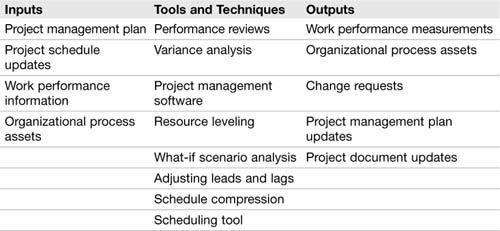
The control schedule process identifies any departures from the project schedule. What happens if work is falling behind? Your recourse is to implement corrective or preventive actions or a change request to align the project execution with its expected results and timelines.
Some options available at this time could be to
![]() Update the project baseline to reflect the current situation using the documented change process.
Update the project baseline to reflect the current situation using the documented change process.
![]() Level resources. When possible, reassign over-allocated resources to avoid schedule conflicts.
Level resources. When possible, reassign over-allocated resources to avoid schedule conflicts.
![]() Crash the schedule. Add people (internal/external) or resources to the tasks that have fallen behind and have a direct effect on the critical path; the down side is that this might cause unscheduled expenses.
Crash the schedule. Add people (internal/external) or resources to the tasks that have fallen behind and have a direct effect on the critical path; the down side is that this might cause unscheduled expenses.
![]() Fast track. Rearrange your activities to perform activities in parallel.
Fast track. Rearrange your activities to perform activities in parallel.
![]() Outsource the project or the affected part.
Outsource the project or the affected part.
![]() Reduce the scope of the project.
Reduce the scope of the project.
The second process, control costs, ensures that the work is occurring within the project budget and identifies any variances early in the process. Table 6.6 shows the inputs, tools and techniques, and outputs for the control costs process.
TABLE 6.6 Control Costs Inputs, Tools and Techniques, and Outputs
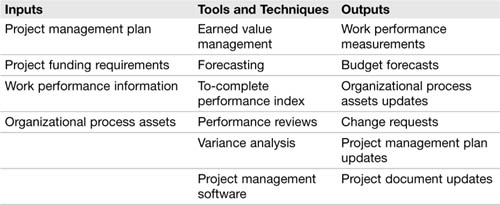
The control costs process identifies any areas that are costing more than planned. As a project moves toward completion the value of the project’s deliverables changes. The “value” of a project at any point in time is known as its earned value. One method of comparing the earned value of a project to the budget is earned value analysis.
Remember that the whole idea behind a corrective or preventive action is to help preserve the healthy execution of your project and maximize its resource utilizations.
Identifying Variance with Earned Value Management
Earned value analysis is a tool used to help in identifying how well the team is performing and where the project might end up in comparison to the project plan. It was initially conceived by the United States Department of Defense (DoD) as a tool to standardize the way contractors report on the progress of their assigned projects.
The three key variables involved in the project earned value analysis are
![]() Budgeted cost for work scheduled (BCWS)
Budgeted cost for work scheduled (BCWS)
![]() Budgeted cost for work performed (BCWP)
Budgeted cost for work performed (BCWP)
![]() Actual cost for work performed (ACWP)
Actual cost for work performed (ACWP)
To successfully report on earned value management, your project must have a well-defined WBS and an effective task planned versus actual performance reporting system.
A basic utilization example is as follows:
The budgeted cost for work scheduled (BCWS) is the planned value of the work according to the project budget. The BCWS of a 12 milestone/144 work packages project is $200,000, and the cost for every three milestones has been estimated to cost $50,000.
The actual cost for work performed (ACWP) is how much you really have incurred in the project. In this example, you are at milestone 6 and the project has used $80,000; therefore, your ACWP is $80,000.
The budgeted cost for work performed (BCWP) is the value of how much work has been completed. So while your ACWP is $80,000, your BCWP is $100,000.
Armed with this information, you can determine derivative calculations such as the schedule performance index (SPI) and the cost performance index (CPI).
SPI = EV/PV(BCWP/BCWS)
= (100000/200000
= .5 Your project is behind schedule.
CPI = EV/AC(BCWP/ACWP )
= (100000/80000)
= 1.25 Your project is using less money than expected.
Perform Quality Control
In the project context, quality is not only defined as delivering the right thing at the right time and at the right cost, but also delivering to customer expectations. As such, you, the project manager, have to ensure that the required metrics, tolerances, reports, and checklists are in place to ensure a quality-prone execution and delivery sandbox is in place. The perform quality control process enables the project manager to assess the level of quality of the project’s deliverables and take any required action. Table 6.7 shows the inputs, tools and, techniques, and outputs for the perform quality control process.
TABLE 6.7 Perform Quality Control Inputs, Tools and Techniques, and Outputs
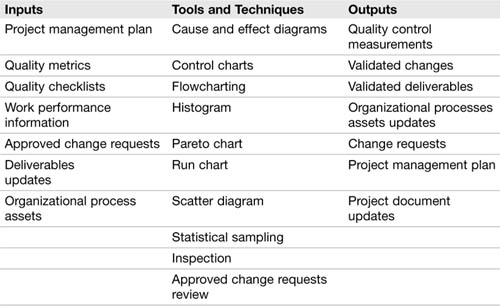
Diagrams and Charts Used to Measure Quality Control
The three diagrams that follow are typical diagrams or charts used to help monitor quality control:
![]() Ishikawa diagram—This diagram type can be easily identified because it resembles fish bones. It is used to determine the root cause of a defect (see Figure 6.2).
Ishikawa diagram—This diagram type can be easily identified because it resembles fish bones. It is used to determine the root cause of a defect (see Figure 6.2).
FIGURE 6.2 Cause and effect diagram
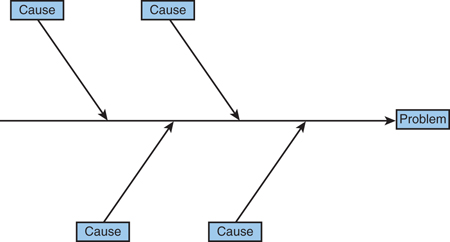
Remember that a product or task defect is the symptom, but not the cause of the problem. This is why the fishbone diagram is effective in graphically displaying what might be causing a problem at the end of the production line.
![]() Control charts—Control charts are a statistical tool used to identify process points that are outside of the normal flow of a process. They help to graphically display process execution boundaries, its trending, and its overall performance over time (see Figure 6.3).
Control charts—Control charts are a statistical tool used to identify process points that are outside of the normal flow of a process. They help to graphically display process execution boundaries, its trending, and its overall performance over time (see Figure 6.3).
FIGURE 6.3 Trending and performance control chart

![]() Pareto charts—Also know as the 80/20 rule. Vilfredo Pareto postulated that the distribution of income and wealth follows a regular logarithmic pattern where 20% of the population controls 80% of the wealth. Subsequently in 1937 Dr. Joseph M. Juran adapted Pareto’s economic observations to business applications, which he called the “vital few and trivial many.” Translated to project terms, 80% of the problems are caused by 20% of the activities (see Figure 6.4).
Pareto charts—Also know as the 80/20 rule. Vilfredo Pareto postulated that the distribution of income and wealth follows a regular logarithmic pattern where 20% of the population controls 80% of the wealth. Subsequently in 1937 Dr. Joseph M. Juran adapted Pareto’s economic observations to business applications, which he called the “vital few and trivial many.” Translated to project terms, 80% of the problems are caused by 20% of the activities (see Figure 6.4).
FIGURE 6.4 Pareto chart displaying error trend in a software development project
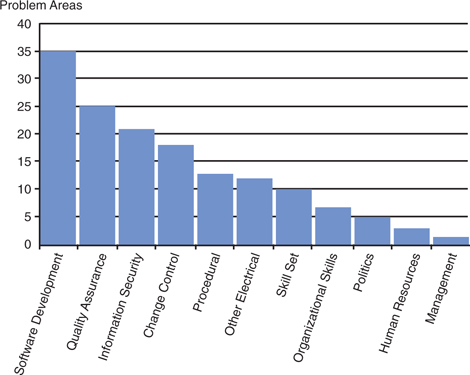
Cram Quiz
Answer these questions. The answers follow the last question. If you cannot answer these questions correctly, consider reading this section again until you can.
1. The activity that is most concerned with current status of the project schedule is
![]() A. Project time management
A. Project time management
![]() B. Project risk management
B. Project risk management
![]() C. Monitoring and controlling
C. Monitoring and controlling
![]() D. Control schedule
D. Control schedule
![]() E. Answers C and D
E. Answers C and D
2. The Ishikawa diagram, control charts, Pareto chart, and statistical sampling are examples of
![]() A. Assure quality
A. Assure quality
![]() B. Control quality
B. Control quality
![]() C. Six Sigma
C. Six Sigma
![]() D. None of the above
D. None of the above
3. The most commonly used performance measure for evaluating if work is being completed as planned at any given time point in a project is which of the following?
![]() A. Cost variance (CV)
A. Cost variance (CV)
![]() B. Schedule variance (SV)
B. Schedule variance (SV)
![]() C. Both A and B
C. Both A and B
![]() D. Neither A nor B
D. Neither A nor B
4. You’re managing a project using the earned value technique (EVT) for cost management. The project planned value (PV) is $200,000. The project earned value (EV) is $100,000. The actual value (AV) is $150,000. What is the cost variance (CV) for the project?
![]() A. 100,000
A. 100,000
![]() B. −100,000
B. −100,000
![]() C. 50,000
C. 50,000
![]() D. −50,000
D. −50,000
Cram Quiz Answers
1. Answer D is correct. One of the schedule control deliverables is to determine the current status of the project schedule.
2. Answer B is correct. The Ishikawa diagram, the control charts, Pareto chart, and statistical sampling are examples of basic tools of control quality.
3. Answer C is the best response. The most commonly used performance measure for evaluating whether work is being completed as planned at any given time in a project is both cost variance (CV) and schedule variance (SV). Answers A and B are both individually correct, but Answer C is the best answer. Answer D is incorrect.
4. Answer D is the correct response. Cost variance (CV) is calculated by subtracting the actual cost (AC) from the earned value (EV). CV=EV−AV. In the example given, the AC is $150,000 and the EV is $100,000. $100,000–$150,000=-$50,000. Answer A is incorrect. Answer B is the schedule variance (SV), not the CV, so it is incorrect. Answer C is incorrect.
Communications, Risk, and Procurement Management
![]() Report Performance—10.5
Report Performance—10.5
![]() Monitor and Control Risks—11.6
Monitor and Control Risks—11.6
![]() Administer Procurements—12.3
Administer Procurements—12.3
The remaining processes in the monitoring and controlling process group provide the project manager with the tools and direction for assessing project communication, risk, and procurement. These processes complete the description of how the project manager ensures that the project is operating as intended.
Communicating How Your Project Is Performing
Communicating with the project team and the outside world is one of the project manager’s primary jobs. As a communicator, the project manager must understand the mechanics involved in sending a message. There has to be an initiator, encoding of the message, sending of the message, and the receiver whom decodes the message, acknowledges the message, and, last but not least, confirms receipt of the message. It is important to maintain open communication with the stakeholders to provide timely and informative updates of the project’s progress. The report performance process addresses issues with communicating with the stakeholders. Table 6.8 shows the inputs, tools and techniques, and outputs for the report performance process.
TABLE 6.8 Report Performance Inputs, Tools and Techniques, and Outputs

In the normal exchange of information with the stakeholders, the project manager will use methods and techniques that help with formal and informal communication. Formal methods include items such as contracts, status reports, public speeches, and performance appraisals. Informal methods are those such as “The Scuttlebutt,” email, and telephone conversations.
With this in mind, it is important to adjust the message and its delivery method based on the audience and the level of impact the project might have on the individuals with whom the project manager is communicating. For example, consider a board member versus the person doing the work. For the worker, getting information about revenue projections and return on investment might be of little or no consequence in her daily duties. However, providing figures on how many additional widgets can be made in an hour would definitely have an impact on her duties and equipment maintenance cycles.
In addition, the project manager must be cognitive that when delivering a message, nonverbal communication and physical appearance have a direct effect on the message been delivered. For example, the project manager delivers a message to a construction team. First, ensure that language and colloquialism used are appropriate to the group. Bear in mind, though, that the same approach might not work when giving a project update to the company senior team. It is important to ensure that the message and intentions are clearly understood by the audience who is the target of the message.
Examples of common tools used to communicate are a budget, a contract, a teleconference, and a chart.
Monitor and Control Risk
The monitor and control risk process enables the project manager to keep track of how risk responses are performing against the plan, as well as the place where new risks to the project are managed.
TABLE 6.9 shows the inputs, tools and techniques, and outputs for the monitor and control risks process.
TABLE 6.9 Monitor and Control Risks Inputs, Tools and Techniques, and Outputs

Remember that to determine how much of an effect a risk will have, multiply its probability by its material impact. As the probability of risk materialization increases, the risk register should make resource (money, equipment, people, and time) allocations ahead of time, thus increasing reserves. It is also important that the risk management plan include the processes that would replenish these reserves before they become depleted.
The purpose of project risk control is to
![]() Identify the events that can have a direct effect in the project deliverables
Identify the events that can have a direct effect in the project deliverables
![]() Assign qualitative and quantitative weight—the probability and consequences of these events that might impact the project deliverables
Assign qualitative and quantitative weight—the probability and consequences of these events that might impact the project deliverables
![]() Produce alternate paths of execution for events that are out of your control or cannot be mitigated
Produce alternate paths of execution for events that are out of your control or cannot be mitigated
![]() Implement a continuous process for identifying, qualifying, quantifying, and responding to new risks
Implement a continuous process for identifying, qualifying, quantifying, and responding to new risks
The risk register accounts for positive and negative risks. A positive risk is a risk taken by the project because its potential benefits outweigh the traditional approach. A negative risk is one that could negatively influence the cost of the project or its schedule.
One of the techniques to evaluate risk control and monitoring effectiveness is to compare actual risk resolution practices to those that were planned at the time the risk was identified. Any deviations (negative or positive), would be cause to implement a corrective action in the risk management plan.
Remember that for each identified risk, it is important to provide a response plan. It is not much help if the risk becomes a reality and there is no alternate execution path or an emergency procurement plan.
In addition, the risk reserves must be evaluated to determine the best way to replenish them. Some examples of events that could have a negative impact in your risk mitigation and control strategies are
![]() Resource shortage
Resource shortage
![]() Scope creep
Scope creep
![]() Contractual issues
Contractual issues
![]() Lack of key resources availability
Lack of key resources availability
Administer Procurements
The administer procurements process is the blueprint for managing the procurements process and making any changes as necessary. It is the process of comparing vendor or service performance to the contractual service level agreements (SLA). Due to its implications and its potential effect across several sections of the project or the enterprise, all team members must be aware of the legal ramifications of any change in the contractual relationship. In addition, project-vendor disbursements tend to tie the SLAs, or performance agreements, and deliverables to direct cash expenditures.
TABLE 6.10 shows the inputs, tools and techniques, and outputs for the administer procurements process.
TABLE 6.10 Administer Procurements Inputs, Tools and Techniques, and Outputs
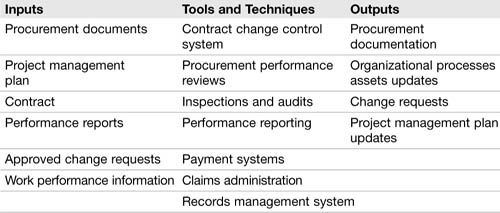
In general, the project procurements administrator is from the procurement management office and/or your legal department and has the authority to issue change requests or early terminations.
Remember that all communications pertaining to procurement administration must follow formal channels and be logged in your project log.
Your procurement administration process should include mechanisms that allow for contract renegotiation, management response, and payment terms definitions.
Cram Quiz
Answer these questions. The answers follow the last question. If you cannot answer these questions correctly, consider reading this section again until you can.
1. Before risk mitigation can occur, _________ and ________ must be accomplished.
![]() A. Acceptance, delivery requirements
A. Acceptance, delivery requirements
![]() B. Identification, trigger recognition
B. Identification, trigger recognition
![]() C. Phasing, interactions
C. Phasing, interactions
![]() D. Quantitative, qualitative analysis
D. Quantitative, qualitative analysis
![]() E. None of the above
E. None of the above
2. Which of the following is not an output to the monitor and control risks process?
![]() A. Change requests
A. Change requests
![]() B. Risk register updates
B. Risk register updates
![]() C. Risk-related contract decisions
C. Risk-related contract decisions
![]() D. Project document updates
D. Project document updates
3. Which of the following processes utilize inspections as a tool or technique?
![]() A. Perform integrated change control
A. Perform integrated change control
![]() B. Control schedule
B. Control schedule
![]() C. Monitor and control risks
C. Monitor and control risks
![]() D. Administer procurements
D. Administer procurements
4. Which of the following is NOT a tool and technique of the report performance process?
![]() A. Variance analysis
A. Variance analysis
![]() B. Interpersonal skills
B. Interpersonal skills
![]() C. Forecasting methods
C. Forecasting methods
![]() D. Communication methods
D. Communication methods
Cram Quiz Answers
1. Answer B is correct. Before risks can be mitigated, you need to know how probable is it that they will occur and what their triggering events are.
2. Answer C is correct. Risk-related contract decisions is an output to the plan risk response process. Change requests, risk register updates, and project document updates are all outputs of the monitor and control risks process.
3. Answer D is correct. Of the processes listed, only administer procurements utilizes inspections and audits as a tool or technique. None of the other processes utilize inspections. Of all the 42 processes, verify scope and perform quality control also utilize inspection.
4. Answer B is correct. Interpersonal skills is a tool and technique of the manage stakeholder expectations process. All of the other answers are valid tools and techniques of the report performance process.
What Next?
If you want more practice on this chapter’s exam topics before you move on, remember that you can access all of the Cram Quiz questions on the CD. You can also create a custom exam by topic with the practice exam software. Note any topic you struggle with and go to that topic’s material in this chapter.
